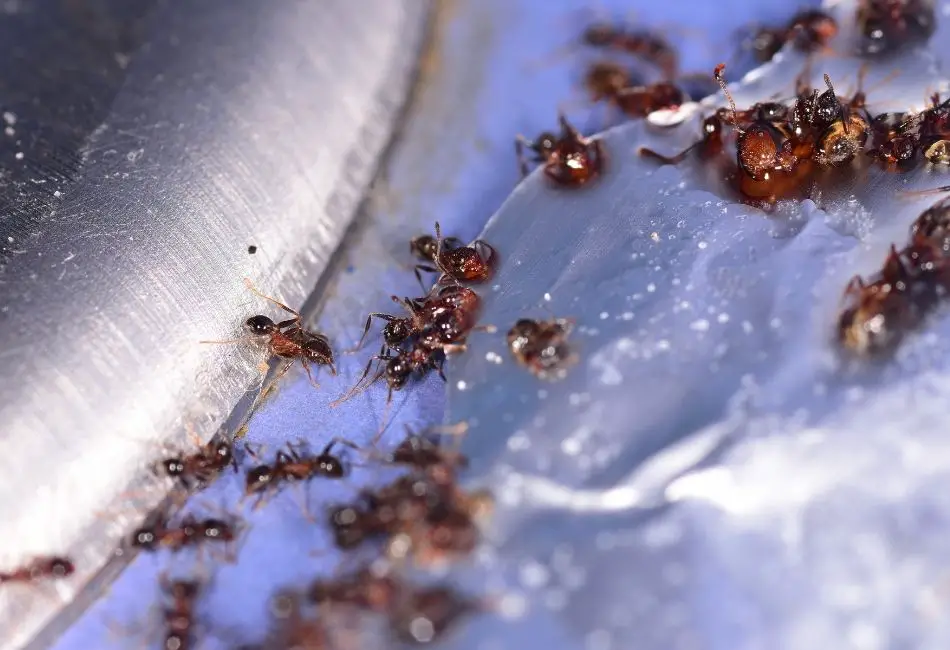If you’ve been seeing ants in your bathroom sink, you’re not alone. Ants often invade homes through the plumbing, looking for water and food. They can penetrate even the tiniest openings to get inside your home.
As soon as you see ants in your bathroom sink or any other place in the house, it is important to act fast and deal with them before they become a full-blown infestation. In this article, we’ll talk about what causes ants in bathroom sinks, how to get rid of them, and how to prevent ants from coming out of the bathroom sink.
What Are The Possible Causes Of Ants In Your Bathroom Sink?
Ants don’t just come out of bathroom sinks. In fact, if you’ve seen any ants in your bathroom lately, it could be any one of these reasons.
1. Food Particles In The Sink Drain
Food particles stuck in the sink drain is the most obvious reason for ants to find their way up to your bathroom sink. When you put food items down the drain, they pass through several plumbing pipes before finally reaching the sewer.
Some of these particles get stuck in the pipe along with other gunk and residue that goes into your sink every day. And where there is food, ants will follow. Ants have a strong sense of smell and will find their way to the food particles in your bathroom sink. Ants are in constant search of food and this is one of the easiest ways for them to find it.
2. Clogged Or Dirty Bathroom Sink
A clogged bathroom sink or a dirty bathroom also attracts ants because of the food particles and moisture it creates. Ants will get attracted to your dirty and smelly bathroom sink if you haven’t cleaned it in a while, especially if you often put things down the drain. Ants will eat anything they can get their little mouths on this including any particle in the clogged bathroom sink.
3. Cracked Or Damaged Drain
A plumbing problem such as a cracked or damaged drain can be caused by almost anything and everything. It may be as a result of an old pipe, wear and tear, hard water, or damage from installation or repairs. If there is a hole or crack in your drain, it can easily let ants inside your bathroom sink. Also, If your bathroom sink hasn’t been properly sealed, it may also cause ants to find their way into your home through the bathroom sink.
4. Moisture Around The Bathroom Sink
Ants are attracted to moisture and damp areas and will go where they think there is flowing water because they need a source of water for their survival. When there is a leak in the faucet or sink, it can cause water to sip through the surrounding wood creating a dump environment. This creates a favorable environment for ants to survive.
5. Drain Close To Nearby Garden
When your bathroom sink drain is close to a nearby garden, it can be easy for ants to find their way into your bathroom. Ants are known to travel long distances in order to find food and if your bathroom sink is close to a garden, they will easily invade your home through the drain.
6. Cracks And Openings Around The Sink
When there are cracks and openings around your bathroom sink, it can be an easy entryway for ants. For example, cracked walls and tiles, and holes in the sink or fauces. These cracks and openings may be a result of poor installation or damage, providing space for ants to crawl their way into your bathroom sink and even making their nest in between these openings.
Nearby areas around the bathroom sink with cracks provide space for a collection of debris and water making the place attractive for ants.
How To Get Rid Of Ants In Your Bathroom Sink
Once you’ve identified the possible causes of ants in your bathroom sink, it’s time to get rid of them. Here are a few ways to do that:
1. Use Boiling Water
boiling water is a natural way of getting rid of ants. When you pour boiling water down the sink drain, it will kill any ants that are in the way and also stop them from coming back. Be sure to pour a good amount of hot water so that it reaches all the way down to the pipes. Not only will boiling kill the ants but also clear grime in the drain.
Take extreme caution when using boiling water as it can cause serious burns.
2. Use An Ant Killer
If boiling water isn’t your thing or if you’re dealing with a large infestation, you can also use an ant killer. There are many different types of insecticides available in the market, so be sure to choose one that is specifically meant for killing ants. Follow the instructions carefully and be sure to keep children and pets away from the area while you’re using it.
3. Use White Vinegar And Baking Soda
White vinegar and baking soda mixture is another powerful way of getting rid of ants in your bathroom sink. Pour a cup of baking soda and a cup of white vinegar into the drain. Allow it to work for about 15 minutes before flushing with hot water. This will kill any ants that are stuck in the drain, get rid of grime, and clear up clogged drains as well. White vinegar also has a strong smell that will deter ants from coming back.
How to prevent ants from coming out of the bathroom sink
Once you’ve gotten rid of the ants in your bathroom sink, it’s important to take some preventative measures so that they don’t come back. Here are a few ways;
1. Clean Your Bathroom Sink Regularly
The best way to prevent ants from coming into your bathroom sink is to clean it regularly. When there is no food or moisture for them to feed on, they will have no reason to invade your bathroom sink. Make sure you disinfect and clean your sink at least once a week. You can do this with soap and boiling water or baking soda and vinegar to remove any traces of organic matter and any clog in the sink drain.
2. Eliminate moisture and dump environment
When talking about ant prevention, eliminating moist environment is one of the best ways to do that. A dump environment serves as a breeding ground for ants and other pests, so you need to make sure your bathroom stays dry at all times. Check if there are any leaks in the sink faucet or around it and repair them immediately to avoid attracting ants into your home.
3. Locate And Seal Any Cracks
Ants can get through any available opening into your bathroom sink. It is therefore necessary to locate and seal any cracks or openings around the sink. These can be caulked using a silicone-based caulk that is specifically meant for sealing cracks and holes.
4. Replace Damaged Plumbing Pipes
Consider replacing old and damaged plumbing pipes that may be the source of moisture in your bathroom sink. Call a professional plumber if you notice any leaks or damages and get them fixed right away if you are not comfortable doing it yourself. It is better to allow a professional to fix it correctly than to try to do it yourself and end up making the problem worse.
Summary
Having ants filling in and around your bathroom sink is an unpleasant thing to see. But with a few simple steps, you can get rid of them and prevent them from coming back. Clean regularly, eliminate moisture, locate and seal any cracks and replace old plumbing pipes to stop ants from invading your bathroom sink. Do these things and you’ll be ant-free in no time.

